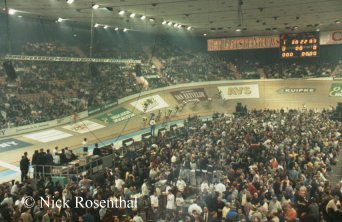
 |
|
Click on the underlined headings for specific details and news and results.
Amsterdam Six (NED) 17.10.2005 - 22.10.2005
Take a look here for photos of the 2002 Amsterdam six-day race.
Dortmund (GER) 27.10.2005 - 01.11.2005
Grenoble (FRA) 27.10.2005 - 01.11.2005
Click here for pics of the 2002 Grenoble six-day bike race. But why, oh why, do they have to organise it at exactly the same time as the Dortmund Six?
München (GER) 10.11.2005 - 15.11.2005
Take a look at a previous Munich Six.
Ghent (BEL) 22.11.2005 - 27.11.2005
Follow this link for photos from the 2004 Ghent Six or here for even more 2004 action racing pics
How to book tickets for the 2004 Ghent Six
Rotterdam (NL) 05.01.2006 - 10.01.2006
The second year that the Rotterdam Six has been back on the calendar.
Bremen (GER) 12.01.2006 - 17.01.2006
Stuttgart (GER) 19.01.2006 - 24.01.2006
Featuring three-man teams!
See Fat Nick's photos from the January 2003 Stuttgart Sechstagerennen.
Berlin (GER) 26.01.2006 to 31.01.2006
Read about Fat Nick's last visit to the Berlin Six.
Copenhagen (DEN) 2.02.2006 to 7.02.2006
The Copenhagen six--days has been missing for the last couple of years after the roof of the new Siemens Arena in Ballerup collapsed in 2003, but Fat Nick understands the roof should be repaired in time for the 2006 Copenhagen Six.
Hasselt (BEL) 9.2.2006 - 14.2.2006
What better way to celebrate Valentine's Day than watching the end of a six-day race in Belgium! This race is a new entry to the calendar for 2006.
Moscow (RUS) ??
And don't forget the ever-exciting Revolution Track Meetings at Manchester Velodrome, now in their third year:
- Event 1 (Revolution 09) - 15th October 2005
Event 2 (Revolution 10) - 19th November 2005
Event 3 (Revolution 11) - 21st January 2006
Event 4 (Revolution 12) - 18th February 2006
The first Six Day races were exactly that - cycle races held over six days and six nights on a bicycle, on a banked cycle track. Some might say that the organisers of such events must have been cruel and uncaring people, but that would be untrue. In their kindness, they allowed the cyclists to race in teams of two. Only one rider from each team actually had to be on the track at any one time, so the second rider could eat, rest or even sleep for a few minutes.
Admittedly, watching exhausted cyclists circle a track for six days did not always make for exciting racing, so the formula was refined. Nowadays, the riders race on an indoor track (or velodrome) over six successive evenings. The cyclists still race in teams of two, and only one rider needs to be in the race at any one time. Generally, the rider not actually racing will circle slowly at the top of the track, waiting for his partner to (literally) throw him into the race by a hand sling.
Rather than one long race lasting all night, an evening's racing typically includes a few Madison sessions (the mainstay of the event) lasting an hour or so each, interspersed with "crowd pleasers" such as riders competing for the fastest flying lap time, or Derny races (where the cyclists are paced behind very odd little motorbikes). Only one rider from each team is needed for these events, which enables the other rider to rest before the next race.
The race is won by gaining points in sprints that are held every 20 laps or so, and by gaining laps on the other riders. Gaining laps is actually more important than scoring points, as the points are only used to differentiate between teams on the same number of laps. Six Day events give riders an extra lap every 100 points, which makes the mathematics of it all even more interesting - although you don't get this "bonus lap" if you pass a 100-point marker during the crucial final Madison of the six days. And while we're in a technical frame of mind, do read Kris Westwood's description of life as a six-day mechanic.
After a low-point of just 8 Six Day races on the calendar for the 1999-2000 season, down from 12 the previous year, we are now back up to 10 events on the calendar for 2002-2003 season, including the new race in Amsterdam at the start of the winter season. The racing normally starts in the early evening and goes on until late in the night. This year, though, we mourn the demise of the Zurich Six, famous for derny paced Madison races (with changes!), and for finishing at five in the morning.
There is a good social atmosphere (for the spectators, in any case!) at six-day bike races. For example, the Munich 6-Day race featured a funfair around the outside of the track, with five restaurants, too many bars to count, and a nightclub in the cellar that opened at two in the morning (when the racing finished).
Check out the results from 1998/99 six-day races.
Check out the results from 1997/98 six-day races.
Return to Fat Nick's main page